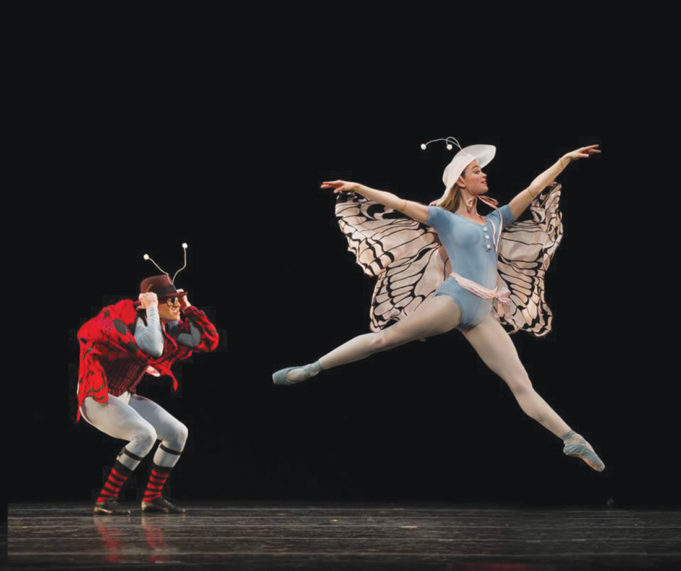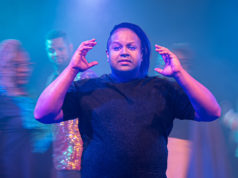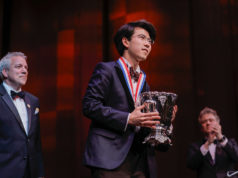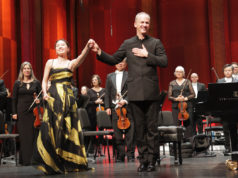Ben Stevenson, artistic director of Texas Ballet Theater, turns 80 next month, and the company began celebrating early last weekend with a stunning triple bill at Bass Performance Hall. Classic Combination featured three great works from the middle of last century: George Balanchine’s Allegro Brillante, Jerome Robbins’ The Concert (Or the Perils of Everybody), and Harald Lander’s Etudes.
Unfortunately, Saturday night got off to a slow start with a matter-of-fact performance of the Balanchine piece. The ballet, set to Tchaikovsky’s Third Piano Concerto, a one-movement work he never lived to complete, packs a lot of punch in a short time. Balanchine filled the 1956 ballet with some of his most original choreography and was quoted then as saying, “It contains everything I know about classical ballet in 13 minutes.”
Yet there were few sparks from the stage. Dancers moved well and handled their assignments nicely but seemed to have little to say. For some reason, leading ballerina Katelyn Clenaghan, a lovely dancer, kept a blank face throughout, contributing to the distant feeling. The Fort Worth Symphony Orchestra, led by Michael Moricz, did its best to liven things up, playing with strength and sensitivity, and kept the piece alive.
Happily the mood changed with Robbins’ comedy. Everyone seemed to have fun performing this parody of theater and classical dance.
The ballet started with the curtain’s rising to reveal a stage that was empty save for a grand piano stage right, keyboard facing the audience. After a few moments, a formally dressed man, pianist Shields-Collins Bray, walked slowly across the stage, sat down at the piano, and began dusting the keys with his handkerchief.
The sight gags carried all the way through to the end. As the pianist’s audience trickled in, carrying white folding chairs, no one seemed sure where to sit. A timid man kept moving, afraid he was offending someone. Another man arrived in a black-brimmed hat chomping a cigar and carrying a newspaper (Carl Coomer) that he began to read after sitting down. A woman looking like a movie star (Carolyn Judson), with a large hat and oversized glasses, tried several places before settling on the far end of the piano, laying her arms on the instrument and resting her face. Later, someone needing a chair snatched hers away, leaving the dancer on pointe in sitting position still resting her head on the piano, apparently unaware the seat was missing.
As Bray played a collection of Chopin music, his listeners evolved into a series of clever, comedic vignettes, some theatrical, others pure dance. The “Raindrop” Prelude introduced several dancers holding black umbrellas, opening and closing them singly and in groups before ending up squashed together under one umbrella.
A classical ballerina corps came on –– and, true to the script, promptly fell apart. Someone’s head turned the wrong way. Another did the wrong step or missed a beat. One dancer totally forgot where she was and stood fast until her colleagues came back. Male dancers dashed across the stage carrying their partners in bizarre positions: sideways, upside down, clutched like a bundle to their chests, executing all kinds of madcap lifts. It reminded me of Les Ballets Trockadero de Monte Carlo, the all-male troupe whose members don tutus and toe shoes to spoof classical ballet. Only here, real women poked fun at themselves. Either way it was great fun.
The ballet ended with cavorting butterflies filling the stage, at which point Bray slammed down the keyboard lid, grabbed a convenient butterfly net, and chased the insects around as the curtain came down.
Bray was really an unsung hero of the evening, giving a heroic account of the Tchaikovsky concerto in the pit, playing the entire Robbins ballet onstage, and performing again in the pit during Etudes, with no billing in the printed program.
This homage to ballet from its five basic positions to completed dance closed the program and brought TBT to a new level of excellence.
Set to the piano music of Carl Czerny, orchestrated by Knudåge Riisager, the ballet opened on a dark empty stage. An overhead spotlight came on and a single ballerina (Allisyn Caro) was seen standing downstage, outlining the five basic ballet positions. Unseen around the perimeter of the stage was a circle of rehearsal barres with dancers waiting at each. When Caro stopped, lights came on the first barre, illuminating dancers from the hips down. They performed the first position, and the process continued around the stage for each position.
The meat of the ballet was the part with two sequences showing off Romantic and classical dance styles. Leticia Oliveira was sensational dancing both. In the extended Romantic adagio, she captured the gentle, floating, almost ethereal quality of the movements as exquisitely as I’ve ever seen. The only ballet we see much today from that era is Giselle, and few ballerinas can dance it like this.
Oliveira changed gears in the classical series and came out like a fury with her familiar rapid turns, jumps, and all of the acrobatic moves in her arsenal. Her partners were Andre Silva and Jyian Dai, who kept right up with her.
Many recall Silva as the young, powerful dancer who left TBT several years ago for Canada. He returned this season as explosive as ever with a new polish. His leaps, turns onstage and in the air, and whole battery of showtime dancing was remarkable. So too was Dai, who has developed rapidly the last couple of years and came out blazing with great leaps, splits, soft landings, and a bright wide smile.
The three of them earned a tumultuous ovation, a triumph for the company, and a wonderful birthday gift for Stevenson.












